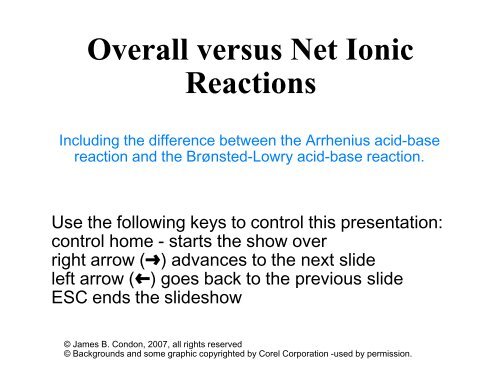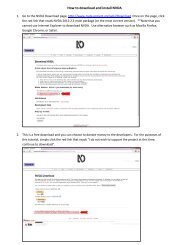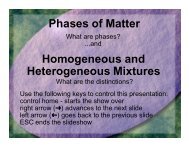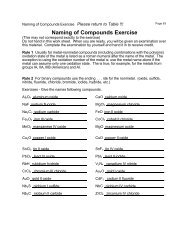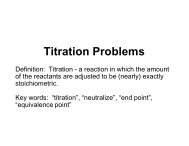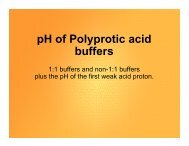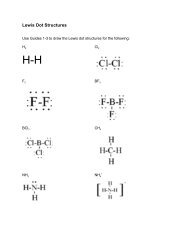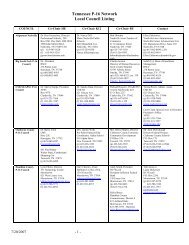Overall versus Net Ionic Reactions
Overall versus Net Ionic Reactions
Overall versus Net Ionic Reactions
You also want an ePaper? Increase the reach of your titles
YUMPU automatically turns print PDFs into web optimized ePapers that Google loves.
<strong>Overall</strong> <strong>versus</strong> <strong>Net</strong> <strong>Ionic</strong><strong>Reactions</strong>Including the difference between the Arrhenius acid-basereaction and the Brønsted-Lowry acid-base reaction.Use the following keys to control this presentation:control home - starts the show overright arrow (º) advances to the next slideleft arrow (») goes back to the previous slideESC ends the slideshow© James B. Condon, 2007, all rights reserved© Backgrounds and some graphic copyrighted by Corel Corporation -used by permission.
Here is an example of a reaction:Ba(NO 3 ) 2 (aq) + Na 2 SO 4 (aq) ! BaSO 4 (s) + 2NaNO 3 (aq)
Here is an example of a reaction:Ba(NO 3 ) 2 (aq) + Na 2 SO 4 (aq) ! BaSO 4 (s) + 2NaNO 3 (aq)(aq) means dissolved in water(s) means this is a solidother symbols you might see are:(l) means liquid(g) means gas
Here is an example of a reaction:Ba(NO 3 ) 2 (aq) + Na 2 SO 4 (aq) ! BaSO 4 (s) + 2NaNO 3 (aq)This reaction has some redundance whenconsidering only the chemistry. How is thisdetermined?Firstly, all strong electrolytes are completely ionizedin solution. This includes all soluble salts*, all strongacids and all strong bases.Let’s break this reaction up into its ions.*with very few exceptions.
Here is an example of a reaction:Ba(NO 3 ) 2 (aq) + Na 2 SO 4 (aq) ! BaSO 4 (s) + 2NaNO 3 (aq)Ba 2+ + 2NO 3–The Ba(NO 3 ) 2 is a salt and the (aq) indicates it is soluble in water,therefore it separates into its ions.
Here is an example of a reaction:Ba(NO 3 ) 2 (aq) + Na 2 SO 4 (aq) ! BaSO 4 (s) + 2NaNO 3 (aq)Ba 2+ + 2NO 3 – + 2Na + + SO 4 2– !The Na 2 SO 4 is a salt and the (aq) indicates it is soluble in water,therefore it also separates into its ions.
Here is an example of a reaction:Ba(NO 3 ) 2 (aq) + Na 2 SO 4 (aq) ! BaSO 4 (s) + 2NaNO 3 (aq)Ba 2+ + 2NO 3 – + 2Na + + SO 4 2– ! BaSO 4 (s)The solid BaSO 4 is not in the water, as indicated by the (s), andtherefore it is not separated into its ions.
Here is an example of a reaction:Ba(NO 3 ) 2 (aq) + Na 2 SO 4 (aq) ! BaSO 4 (s) + 2NaNO 3 (aq)Ba 2+ + 2NO 3 – + 2Na + + SO 4 2– ! BaSO 4 (s) + 2Na + + 2NO 3–The NaNO 3 is a salt and the (aq) indicates it is soluble in water,therefore it also separates into its ions.
Here is an example of a reaction:Ba(NO 3 ) 2 (aq) + Na 2 SO 4 (aq) ! BaSO 4 (s) + 2NaNO 3 (aq)Ba 2+ + 2NO 3– + 2Na + + SO 4 2– ! BaSO 4 (s) + 2Na + + 2NO 3–Notice that there are some redundances in this reaction. These arethe NO 3– ions and the Na + ions.
Here is an example of a reaction:Ba(NO 3 ) 2 (aq) + Na 2 SO 4 (aq) ! BaSO 4 (s) + 2NaNO 3 (aq)Ba 2+ + 2NO 3– + 2Na + + SO 4 2– ! BaSO 4 (s) + 2Na + + 2NO 3–These are referred to as “spectator ions” and may be deleted if oneis only interested in the chemistry of the reaction. Thus:Ba 2+ + SO 42–! BaSO 4
Here is an example of a reaction:Ba(NO 3 ) 2 (aq) + Na 2 SO 4 (aq) ! BaSO 4 (s) + 2NaNO 3 (aq)This reaction written above is called the “overall reaction”. It isuseful for measurements, for example weighing out reactants.This reaction written below is called the “net ionic reaction”. It isuseful for describing the chemistry, that is what is reacting.Ba 2+ + SO 42–! BaSO 4
Here is an example of a reaction:Ba(NO 3 ) 2 (aq) + Na 2 SO 4 (aq) ! BaSO 4 (s) + 2NaNO 3 (aq)This reaction written above is called the “overall reaction”. It isuseful for measurements, for example weighing out reactants.This reaction written below is called the “net ionic reaction”. It isuseful for describing the chemistry, that is what is reacting.Ba 2+ + SO 42–! BaSO 4Later, this will be used for describing equilibrium. If one pours solidBaSO 4 into pure water one will obtain a small amount of Ba 2+ andSO 4 2– ions in solution. A more descriptive writing would show anarrow pointing to the reactants as well.
Here is an example of a reaction:Ba(NO 3 ) 2 (aq) + Na 2 SO 4 (aq) ! BaSO 4 (s) + 2NaNO 3 (aq)This reaction written above is called the “overall reaction”. It isuseful for measurements, for example weighing out reactants.This reaction written below is called the “net ionic reaction”. It isuseful for describing the chemistry, that is what is reacting.Ba 2+ + SO 42–º BaSO 4Therefore a double arrow, º, is inserted in the net ionic reaction toexpress this forward and reverse reaction. This is called anequilibrium.
Another example:HCl + CH 3 NH 2 ! CH 3 NH 3 Cl
Another example:HCl + CH 3 NH 2 ! CH 3 NH 3 ClH + + Cl – + CH 3 NH 2 ! CH 3 NH 3 + + Cl –Rationals:HCl is a strong acid ˆ dissociates into ionsCH 3 NH 2 is a weak base ˆ doesn’t dissociateCH 3 NH 3 Cl is a salt ˆ dissociates into ions
Another example:HCl + CH 3 NH 2 ! CH 3 NH 3 ClH 3 O + + Cl – + CH 3 NH 2 ! CH 3 NH 3 + + Cl – + H 2 OThe Cl – is the redundant ion.
Another example:HCl + CH 3 NH 2 ! CH 3 NH 3 ClThus the net ionic reaction is:H 3 O + + CH 3 NH 2 º CH 3 NH 3+ + H 2 O
Another example:HCl + CH 3 NH 2 ! CH 3 NH 3 ClThus the net ionic reaction is:H 3 O + + CH 3 NH 2 º CH 3 NH 3+ + H 2 OFor acid-base reactions, the overall reaction iscalled the Arrhenius reaction and the net ionicreaction is called the Brønsted-Lowry reaction.
Another example:HCl + CH 3 NH 2 ! CH 3 NH 3 ClArrhenius reactionThus the net ionic reaction is:H 3 O + + CH 3 NH 2 º CH 3 NH 3+ + H 2 OBrønsted-Lowry reaction
A 3rd example:CH 3 COOH + NaOH ! NaCH 3 COO + H 2 O
A 3rd example:CH 3 COOH + NaOH ! NaCH 3 COO + H 2 OCH 3 COOH + Na + + OH –! Na+ + CH 3 COO – + H 2 ORational:CH 3 COOH is a weak acid ˆ doesn’t dissociateNaOH is a strong base ˆ dissociates into ionsNaCH 3 COO is a salt ˆ dissociates into ionsH 2 O is the solvent
A 3rd example:CH 3 COOH + NaOH ! NaCH 3 COO + H 2 OCH 3 COOH + Na + + OH –! Na+ + CH 3 COO – + H 2 ODeleting the spectator ions will yield the net ionic orBrønsted-Lowry reaction.
A 3rd example:CH 3 COOH + NaOH ! NaCH 3 COO + H 2 Ooverall reaction = Arrhenius reactionCH 3 COOH + OH – º CH 3 COO – + H 2 Onet ionic reaction = Brønsted-Lowry reaction
<strong>Overall</strong> <strong>versus</strong> <strong>Net</strong> <strong>Ionic</strong><strong>Reactions</strong>Including the difference between the Arrhenius acid-basereaction and the Brønsted-Lowry acid-base reaction.THE ENDUse the following keys if you do not want to exit.control home - starts the show overright arrow (º) advances to the next slideleft arrow (») goes back to the previous slide


